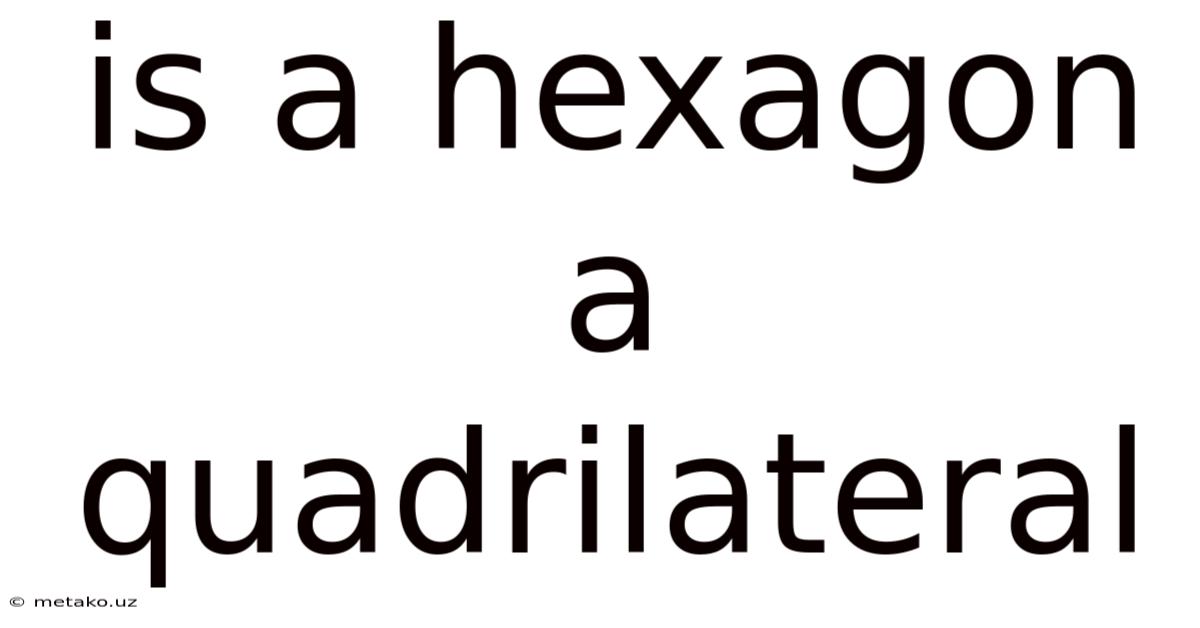Is A Hexagon A Quadrilateral
metako
Sep 17, 2025 · 4 min read

Table of Contents
Is a Hexagon a Quadrilateral? Understanding Geometric Shapes
Is a hexagon a quadrilateral? The simple answer is no. This article delves deep into the definitions of hexagons and quadrilaterals, exploring their properties and highlighting the key differences that make them distinct geometric shapes. Understanding these fundamental concepts is crucial for anyone studying geometry, from elementary school students to advanced mathematics enthusiasts. We will explore the properties of both shapes, address common misconceptions, and provide a clear and concise explanation to solidify your understanding.
Introduction to Geometric Shapes and Definitions
Geometry is the branch of mathematics concerned with the properties and relationships of points, lines, surfaces, solids, and higher dimensional analogs. Understanding basic geometric shapes is foundational to learning more complex concepts. Let's start by defining the key terms:
-
Polygon: A closed two-dimensional figure formed by connecting three or more straight line segments. Each line segment is called a side, and the point where two sides meet is called a vertex.
-
Quadrilateral: A polygon with four sides and four angles. Examples include squares, rectangles, rhombuses, parallelograms, trapezoids, and kites. The sum of the interior angles of any quadrilateral is always 360 degrees.
-
Hexagon: A polygon with six sides and six angles. Examples include regular hexagons (where all sides and angles are equal) and irregular hexagons (where sides and angles may vary). The sum of the interior angles of any hexagon is always 720 degrees.
The core difference lies in the number of sides. A quadrilateral, by definition, must have four sides. A hexagon, on the other hand, must have six sides. These are fundamental, unchanging properties. Therefore, a hexagon cannot possibly be a quadrilateral. The two shapes are mutually exclusive.
Exploring the Properties of Quadrilaterals
Quadrilaterals are a broad category encompassing many different types of shapes. They are classified based on their side lengths, angle measures, and the relationships between their sides and angles. Here are some key properties of common quadrilaterals:
-
Square: All four sides are equal in length, and all four angles are right angles (90 degrees).
-
Rectangle: Opposite sides are equal in length, and all four angles are right angles.
-
Rhombus: All four sides are equal in length, but angles are not necessarily right angles.
-
Parallelogram: Opposite sides are parallel and equal in length. Opposite angles are also equal.
-
Trapezoid (or Trapezium): At least one pair of opposite sides are parallel.
-
Kite: Two pairs of adjacent sides are equal in length.
These properties distinguish each type of quadrilateral from the others. Critically, none of these properties apply to a hexagon. A hexagon, with its six sides, falls outside the definition of a quadrilateral entirely.
Delving Deeper into Hexagons: Properties and Types
Hexagons, like quadrilaterals, exist in various forms. The most common type is the regular hexagon. A regular hexagon is characterized by:
-
Equal Sides: All six sides have the same length.
-
Equal Angles: All six interior angles are equal to 120 degrees.
-
Symmetry: A regular hexagon possesses rotational and reflectional symmetry. This means it looks the same after rotations of 60 degrees and reflections across certain lines.
Irregular hexagons, conversely, can have varying side lengths and angle measures. However, they still adhere to the fundamental definition: six sides and six angles. The sum of the interior angles remains constant at 720 degrees regardless of regularity.
Addressing Common Misconceptions
One common misconception arises from the visual similarity between some irregular hexagons and quadrilaterals with concave sides. A concave polygon has at least one interior angle greater than 180 degrees. While an irregular hexagon might appear to have only four significant vertices when drawn in a specific way, it still retains six sides. Counting the sides is the definitive method for classifying a polygon.
Another misconception might stem from focusing on the area or visual resemblance. Two shapes might have similar areas, but their fundamental properties (number of sides) remain distinct.
Visualizing the Difference: A Practical Approach
Imagine trying to fit four sides into the structure of a hexagon. It’s impossible without fundamentally altering the shape. The presence of six sides inherently excludes a hexagon from the quadrilateral category. The number of sides is the defining characteristic. Visualizing the shapes and counting their sides is a simple and effective way to understand this concept.
The Importance of Precise Definitions in Mathematics
The strict definitions in mathematics are not arbitrary. They provide a clear and consistent framework for understanding and manipulating geometrical concepts. Understanding the precise definitions of shapes like quadrilaterals and hexagons is crucial for further studies in geometry, trigonometry, and calculus.
Conclusion: Hexagons and Quadrilaterals – Distinct Geometrical Entities
In conclusion, a hexagon cannot be a quadrilateral. The fundamental difference in the number of sides (six for a hexagon and four for a quadrilateral) makes them distinct geometrical figures. While various types and properties exist within each category, their core definitions remain constant and unambiguous. Understanding these definitions is essential for mastering basic geometrical concepts and progressing to more advanced mathematical studies. Remember, counting the sides is the decisive factor in classifying a polygon.
Latest Posts
Latest Posts
-
What Does Multiple Alleles Mean
Sep 17, 2025
-
Venn Diagram For 3 Sets
Sep 17, 2025
-
Percent Ideal Body Weight Formula
Sep 17, 2025
-
What Is The Excess Reactant
Sep 17, 2025
-
Fundamental Theorem Of Invertible Matrices
Sep 17, 2025
Related Post
Thank you for visiting our website which covers about Is A Hexagon A Quadrilateral . We hope the information provided has been useful to you. Feel free to contact us if you have any questions or need further assistance. See you next time and don't miss to bookmark.